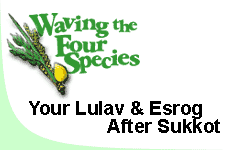 Identifying as a Jew
Identifying as a Jew


2 min read
Mitzvah Recycling! An item used for one mitzvah can be used for another.
After the Sukkot holiday has ended, we are left with a variety of items that we used for mitzvot, but which no longer seem to serve any function. For example, the four species (Lulav, Etrog, etc.), the willow branches from Hoshana Rabba, and the s'chach which formed the roof of our Sukkah.
But we mustn't simply throw these mitzvah items out. Why not? The Torah says that after Abraham purchased a field for Sarah's burial, "the field rose up" (Genesis 23:17). In what way can a field ascend? Rashi explains that when a material object is used for a mitzvah, that object becomes elevated spiritually. The same applies to our elevated mitzvah objects which served to raise us up during the festival.
Items such as a used Lulav, torn Tzitzit, or broken Shofar -- though they no longer retain any intrinsic holiness -- must not be treated disrespectfully by discarding them in a filthy place such as a garbage bin (Mishna Brura 21:6). However it is permissible, according to the letter of the law, to leave the object in a clean place with full knowledge that someone else will come and dispose of it (Mishna Brura 21:7). People who demonstrate extra care take it upon themselves to bury such articles or put them into a geniza (Rama O.C. 21:1).
MITZVAH RECYCLING
There is a beautiful kabbalistic idea of "mitzvah recycling" -- which suggests that any item used for one mitzvah should be used for another (Shulchan Aruch HaRav §12). For example, many save their Lulav sets and extra willows until the eve of Passover, to use them for kindling a fire for the mitzvah of burning chometz (Maharshal responsum §77). Similarly, old Tzitzit once detached from the Tallit can be used as effective bookmarks (Maharil).
Another beautiful practice is to cover the surface of the Etrog with aromatic cloves and use this throughout the year as a spice holder for the Havdallah service. others have the custom to collect dozens of Etrogs and to candy their tart fruit. You can then serve it on Tu Bishvat -- the new year for fruit trees.
Whatever you decide to do with your used mitzvah-objects, remember the underlying principle: Mitzvot are for individuals to express their personal relationship to God, and to be creative within the boundaries of halacha (Jewish law).
